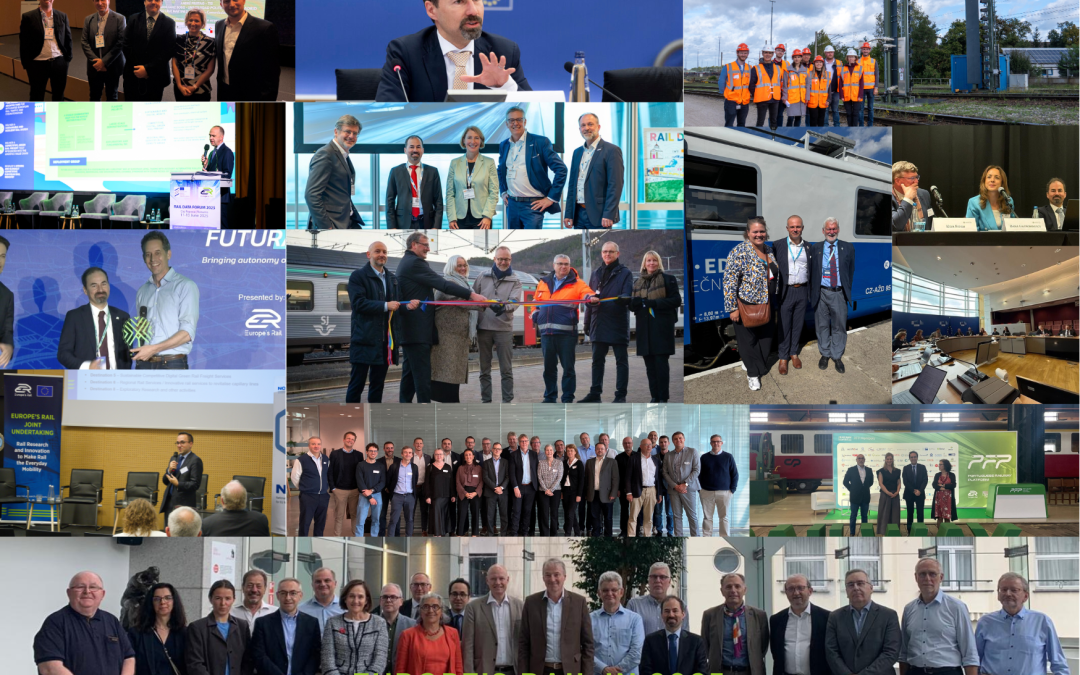2025 saw Europe’s Rail (EU-Rail) make significant progress across multiple initiatives, fostering partnerships and...

Europe must take decisive steps to simplify and modernise its rail systems to strengthen competitiveness, sustainability and sovereignty. That is the central message of the High-Level Paper on “A Future Policy-Based Public-Private Partnership for Rail”, officially adopted by the Governing Board of Europe’s Rail Joint Undertaking (EU-RAIL). The paper proposes a major co-investment strategy between the public and private sector to make rail systems more agile, resilient and competitive across the EU, calling for EUR 18 billion between 2028 and 2034 – with EUR 3 billion for research and innovation, plus EUR 15 billion for pre-deployment of harmonised technologies and system-wide implementation.
The European rail sector is a major socio-economic and sustainable asset, employing 2.3 million people and contributing EUR 143 billion to EU GDP. The European railway value chain is a global leader in design, manufacture and maintenance and it has sustained a positive trade balance over the past decade in an increasingly competitive global market. Yet, to maintain global leadership, Europe must continue to invest in rail’s competitiveness, harmonising and modernising its systems and operations.
To preserve its position, the EU must adopt a bold R&I and deployment strategy. Without a coordinated European approach towards system simplification, the EU’s industrial leadership and competitiveness will be significantly undermined, along with Europe’s ability to respond to passengers’ and businesses’ transport needs.
| “European rail is essential to a prosperous and more sustainable future. It provides a vital service for millions of European citizens and businesses, supporting our industrial base, transport system, and tourism economy. I welcome this strategic contribution, which is timely in view of the next Multiannual Financial Framework. We remain committed to working closely with all partners to ensure that rail continues to be a driving force for Europe’s competitiveness and strategic autonomy”.
Apostolos Tzitzikostas, European Commissioner for Sustainable Transport and Tourism |
Developed by the members of EU-RAIL, the paper sets out ambitious targets to simplify and digitalise rail operations, harmonise standards, and accelerate the deployment of interoperable, affordable, and secure solutions. It builds on the success of Shift2Rail and the current Europe’s Rail programme, while expanding its scope to support policy-oriented research, innovation, and pre-deployment activities, capable to respond to the European Union priorities for a Prosperous and Competitive Europe.
A mission oriented approach
Rail is vital for Europe. A well-functioning rail system is strategically important for the economy and security of the EU and its Member States. Rail is also central to achieving sustainability in transport, being the greenest and most energy efficient mass transport mode, delivering the policy objectives of a Single European Rail Area (SERA) and strengthening the Single Market.
To achieve its mission of simplifying the rail system to make it more attractive, and creating the conditions for a faster and more effective and affordable deployment of innovations, the High-Level paper identifies three core objectives requiring targeted investment:
Turning vision into delivery
This current global industrial leadership within the rail sector has been achieved through the development of products and solutions within the internal European market, with both public and private investments.
The new public-private partnership model would go even further by preparing the rail sector for greater agility in responding to market demands and enhanced competitiveness in the broader transport and mobility landscape.A coordinated EU-level approach is essential due to the cross-border nature of rail operations and the need for standardised solutions. All stages of the innovation pipeline must be supported, from early-stage research and demonstration to pre-deployment at scale.
Pre-deployment activities managed at EU level bridges the “valley of death”, the gap between research and full rollout, reducing risks and validating solutions in real conditions. This creates a stable, coordinated framework for future deployment, where Europe can bring clean technologies to scale, and deliver faster, and more competitive rail services for Europe’s citizens and economy.
The EUR 18 billion investment represents a strategic opportunity to position the EU as a global leader in affordable, flexible and reliable rail solutions and operations.
Success depends on an inclusive and transparent partnership involving operators, suppliers, researchers and universities, SMEs, Member States, and the European Commission.
Towards a stronger Europe
A future-oriented rail system will play a decisive role in Europe’s strategic autonomy and connectivity. It is central to achieving the EU’s 2050 climate neutrality goals, tripling high-speed rail use, and doubling rail freight. The proposed partnership ensures that innovation remains rooted in Europe, supporting skilled jobs, industrial leadership, and open strategic autonomy.
| “Investing in innovation and making it happen together is not just a necessity. It’s an opportunity to build a more competitive, and more independent Europe By focussing to simplify the rail system and therefore reducing complexity across the network, economies of scale can be increased for a more agile, resilient and competitive the rail sector. This approach benefits not only large rail systems but also enhances the development and integration of smaller innovative components, fostering greater efficiency and competitiveness across the European rail sector, creating a lasting value for the EU.”.
Giorgio Travaini, Executive Director, Europe’s Rail JU |
Read here the full High-Level Paper on ‘A future policy based public private partnership for rail’.